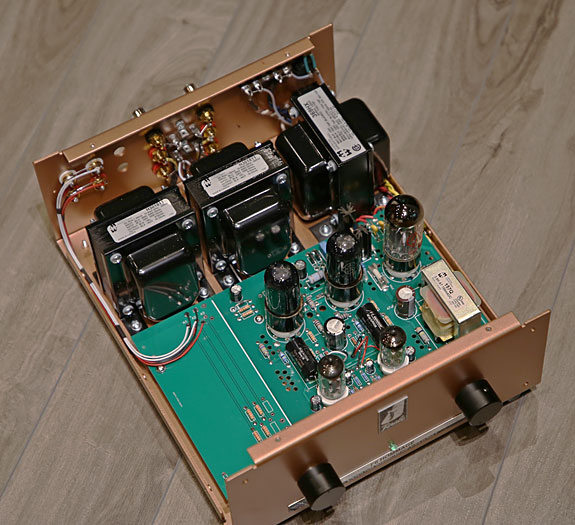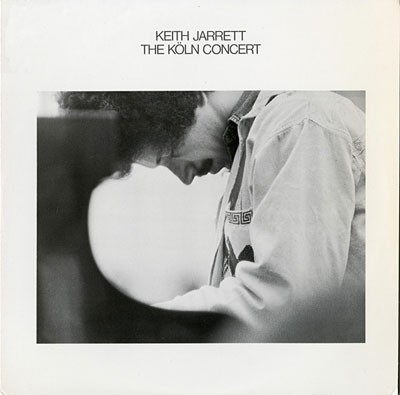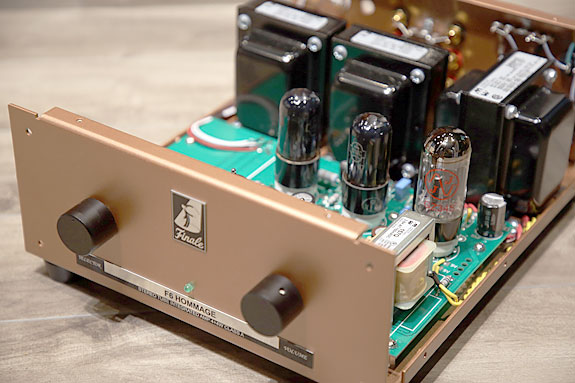December 2023

World Premiere Review!
Finalé Audio F-6 Hommage EF86 Edition Vacuum Tube Integrated Amplifier Review
How low can you go?
Review By Paul Schumann
Sometime in the mid-1990s, I was in a music store and noticed an audio magazine on the rack I had never seen before. It was Issue 12 of Sound Practices. I flipped through it and was fascinated by its retro take on audio, so I made the purchase. I read every article, but Herb Reichert’s Causal Reactions column struck me to the core. This was back during a time when Herb Reichert was an arts school teacher and his vacuum tube efforts were dedicated towards DIY. His basic argument was this: the best way to evaluate an audio system is how it allows you to feel the emotions in your music. All other criteria are secondary.
I know I’ve reduced a beautifully written article into a simple statement. But this statement leads the reader to the next question: What kind of system allows you to do this? For those writers and readers of Sound Practices magazine, the answer was clear: low-power triode-tube amps paired with high-efficiency speakers.

Decisions, Decisions
When someone designs a triode tube amp, they need to make several decisions. Triode tube amps come in two varieties, push-pull (PP) and single-ended triode (SET). A proper push-pull amp is tricky because it splits the signal apart at the input stage and puts it back together at the output transformer. While there are several advantages to this method, it requires great care by the designer to make sure the precious waveform is reassembled without any artifacts. Many folks prefer SET amps since they are easier to implement properly. Then there are the output tubes themselves.
You have the choice of directly-heated triodes (DHT) or indirectly-heated power tubes (IDH) utilized as triodes. With the DHT tubes, the filament (heater) and the cathode are combined in the tube. These are triode output tubes that audiophiles are most familiar with and include the 2A3, 300B, and 211. An IDH tube has a separate heater and cathode. These include the familiar 6V6, 6L6, EL34, EL84, and KT88. These are all pentodes and tetrodes can be wired to behave as triodes. While SETs are valued by audiophiles, they are expensive, generate quite a bit of heat, and take up a lot of space. The IDH tubes are cheaper, run cooler, and are more compact. Your decision depends on your budget and sound preferences.
A Blast From The Past
During the 1950s, there was a boom in hobby electronics. Tube manufacturers like RCA and Mullard sold manuals explaining the basics of audio electronics and containing schematics of equipment an electronic hobbyist could build themselves. One of the amplifiers Mullard offered was the 3-3 integrated amp. It was a mono 3 Watts per channel unit that was designed to be a “simple amplifier of reasonably high quality”. It is an exceedingly simple circuit with an EZ80 rectifier, an EF86 driver tube, and an EL84 power tube connected in a triode configuration. My DIY bud David discovered the schematic for the Mullard 3-3 and built it on a whim.
As soon as he started listening to it, he was startled by its clarity. He believed that the key to sound was Mullard EF86 and its clever implementation in the amp. The EF86 is a super-high gain pentode, which makes it highly sensitive. The more he listened to it, the more he wanted me to hear it too. We worked out a trade. After he tweaked it some more and put it in a nice box, he sent it my way. I immediately fell in love with the thing and knew that it would be one of the main amps in my system. But then the question popped into my head, “Does anyone manufacture something like this I could review?”
Then I had a stroke of good luck. I follow Lynn Olsen on Facebook and I noticed that he had been to audio shows to support a company called Finale Audio. I went to their website and after looking around I stumbled on the F-6 Hommage. I communicated with Peter and Frank of Finale and they were excited about the possibility of a review. They had a new EF86 version which they had just created. Sometimes you just have to be lucky.

As you have probably figured out, the Hommage moniker was attached because the F-6 utilizes the Mullard 3-3 design. The big difference between the F-6 Hommage and Mullard 3-3 is that it utilizes a 6V6 pentode instead of the EL84 on the out and the rectifier is a 5AR4. The F-6 Hommage EF86 Edition is integrated with two selectable inputs and volume control. When I installed the tubes, I noticed Hammond transformers all around and a Hammond choke. Also included are CMC Gold RCA and binding posts, Mundorf Supreme Silver Oil coupling caps, Alps Japan Blue Velvet volume control, and a Lorlin UK selector switch. Overall the F-6 Hommage EF86 Edition looks nice on your equipment rack without taking up much space.

You Need The Right Speaker
As I said, the Mullard 3-3 is a 3 WPC amp. The F-6 Hommage EF86 Edition cranks out 4.5 Watts per channel (Wpc). Either way, you are going to need to pair amps with high-efficiency speakers. For this review, I used my Super Pensil 12.2s and the Coherent Audio “Trim Tens”. Both of these have a rated efficiency of 94dB/W/m. I really wouldn’t recommend using anything less than that.

You Can Never Have Too Much Vinyl
For this review, I decided to listen to some recently acquired vinyl. A couple of months ago I wandered into a local record store a couple of blocks from where I teach and spied Keith Jarrett’s Köln Concert [ECM-2-1064]. Without hesitation, I grabbed it and made it mine with some store credit. (Yes credit. Admit it folks, there are some albums in the collection you haven’t listened to in over twenty years.) Since the purchase, it has been a regular part of my music rotation.
Listening to Köln Concert with the F-6 Hommage EF86 Edition, I was delighted with the warmth and fullness of the piano tone. Sometimes with a piano, the keys to the far right can sound tinny, but that was never the case F-6 Hommage EF86 Edition. I ended up listening to this wonderful album several times with this sweet little integrated. Each time I found it to be a wonderful experience, full of drama and wonder.

Another recent purchase was Pat Metheny’s Bright Size Life [ECM 1073]. I finally got to Pat live in October, and this album was one of the glaring omissions in my collection. After perusing Discogs for several months, I was able to find a copy with the right price and condition. As soon as I dropped the needle, I was immediately floored by the playing of this ensemble. How could he be so confident right out of the box like that? Pat said that playing with Jaco and Bob Moses really pushed him, and I could hear it on the track, “Midwestern Nights Dream”.
Like all great jazz, the music ebbed and flowed between the musicians as Pat and Jaco took turns leading the ensemble. On “Unquity Road”, it is Bob Moses’ high hat that propels the song forward. On “Omaha Celebration” Pat and Jaco play tag with some crazy chord progressions. As always, listening to this album with the F-6 Hommage EF86 Edition was a relaxed experience.

Another album I’ve recently purchased was Herbie Hancock’s Maiden Voyage [BST 84195]. I listened to it several times with the F-6 Hommage EF86 Edition and was always struck by how big this album sounded. It was as if Herbie and his band were right there in my living room. It made for an engrossing experience. Who said 4.5 Watts is too little?

Let’s Enjoy The Music
So let’s go back to our starting question: How did the F-6 Hommage EF86 Edition help me to connect with the emotions of the music? No matter what music I was playing, my right brain was completely engaged in the listening experience. Each time I dropped the needle, I was allowed to experience the passion of the musicians involved.
If you are really interested in exploring the world of low-powered amps and high-efficiency speakers, I would highly recommend the F-6 Hommage EF86 Edition. Finale also makes traditional SET amplifiers if you are interested in upgrading. But who knows? The F-6 Hommage EF86 Edition might be just your ticket to audio nirvana.
| Tonality |  |
| Sub–bass (10Hz – 60Hz) |  |
| Mid–bass (80Hz – 200Hz) |  |
| Midrange (200Hz – 3,000Hz) |  |
| High Frequencies (3,000Hz On Up) |  |
| Attack |  |
| Decay |  |
| Inner Resolution |  |
| Soundscape Width Front |  |
| Soundscape Width Rear |  |
| Soundscape Depth |  |
| Soundscape Extension Into Room |  |
| Imaging |  |
| Fit And Finish |  |
| Self Noise |  |
| Emotionally Engaging |  |
| Value For The Money |  |

Check out Enjoy the Music!
See many great reviews by Enjoy the Music.com at this link.
Specifications
Type: Vacuum tube stereo integrated amplifier
Power Output: 4.5 Watts per channel
Input Gain: 350mv @ 80 kOhm
S/N Ratio: 90dB at rated power output
Tube Complement: Two EF86, two 6V6, and one 5AR4
Dimensions: 11″ x 13″ x 4.5″ (WxDxH)
Price: $4500
Company Information
Finalé Audio
Ontario, Canada
E-mail: email@tubedeforce.com
Website: FinaleAudio.com















Want to join discussion?
Feel free to contribute!